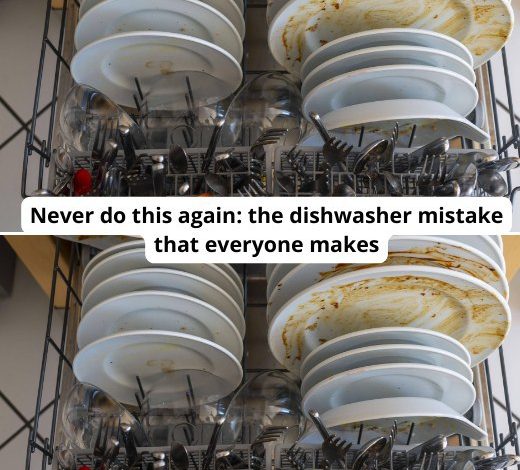Never do this again: the dishwasher mistake that everyone makes

Never Do This Again: The Common Dishwasher Mistake Everyone Makes
The dishwasher is one of the most indispensable appliances in our homes, saving us time and effort after meals. However, despite its convenience, many of us unknowingly make mistakes when loading or using it, leading to dirty dishes, wasted energy, and even damage to the machine. One common mistake, in particular, might be costing you both time and money. This article dives into this dishwasher error and how to fix it for optimal performance.
ADVERTISEMENT
Understanding the Role of Your Dishwasher
Before addressing the common mistakes, it’s important to understand how a dishwasher works. A modern dishwasher operates by spraying water, combined with detergent, at high pressure to clean your dishes. It uses strategically placed spray arms, heated water, and a rinse cycle to remove grease, food residue, and stains. Proper loading and maintenance ensure that the water can reach every surface for effective cleaning.
ADVERTISEMENT
The Dishwasher Mistake Everyone Makes
The mistake? Over-rinsing or improperly stacking dishes. This might sound counterintuitive, especially if you’ve been rinsing your plates before loading them or trying to cram as many dishes as possible into the machine. Let’s break down these errors and why they matter:
ADVERTISEMENT
- Over-Rinsing Dishes Before Loading
Many people believe that pre-rinsing dishes ensures they come out cleaner. However, this habit does more harm than good. Here’s why:
- Why Over-Rinsing Is a Problem:
- Detergents Need Something to Work On: Dishwasher detergents are formulated to cling to food particles. Without residue on the dishes, the detergent can foam excessively and fail to clean effectively.
- Wasted Water: Pre-rinsing uses gallons of water unnecessarily, increasing your water bill and environmental impact.
- Reduced Efficiency: Over-cleaning dishes before loading can trick the dishwasher into running a less thorough cleaning cycle. Sensors in modern dishwashers detect soil levels and adjust the cycle accordingly.
- The Solution:
- Scrape off large food particles into the trash or compost bin, but don’t rinse. Load dishes with visible residue to let your dishwasher and detergent do their job.
- Improper Stacking of Dishes
Improper loading is another widespread mistake. Plates stacked too closely together, utensils bundled in the wrong compartments, and bowls positioned poorly can block water and detergent from reaching every surface.
- Signs of Improper Loading:
- Streaks, grease, or food residue left on plates.
- Unclean glasses with water spots.
- Blocked spray arms that fail to spin properly.
- How to Load Dishes Correctly:
- Plates: Place plates in the bottom rack, facing toward the center. Keep them slightly spaced apart for water to flow freely.
- Bowls and Cups: Use the top rack for bowls, glasses, and mugs. Angle them downward so that water doesn’t pool inside.
- Utensils: Place forks, knives, and spoons in the utensil basket. Alternate the direction of utensils to prevent nesting.
- Pots and Pans: Load large items at the sides or back of the bottom rack, ensuring they don’t block the spray arms.
- Avoid Overcrowding: Give your dishes breathing room. An overcrowded dishwasher reduces water circulation and cleaning performance.
- Using the Wrong Detergent
Another common mistake is using improper detergent or incorrect amounts. For example, liquid dish soap is not a substitute for dishwasher detergent and can cause suds to overflow.
- Tips for Choosing the Right Detergent:
- Use detergents designed specifically for dishwashers, such as pods, powders, or gels.
- Avoid using too much detergent; more isn’t always better. Follow the manufacturer’s instructions.
- Consider hard water: If you live in an area with hard water, opt for detergents designed to combat mineral buildup.
- Ignoring Regular Maintenance
Even a properly loaded dishwasher can fail if the machine isn’t maintained. Neglecting cleaning and maintenance leads to clogs, poor water pressure, and unpleasant odors.
- Steps to Maintain Your Dishwasher:
- Clean the Filter: The filter at the bottom of your dishwasher traps food particles. Remove and rinse it weekly.
- Check the Spray Arms: Clear the spray arms of debris to ensure proper water flow.
- Use Dishwasher Cleaner: Run an empty cycle with a dishwasher cleaning product or a cup of vinegar to remove grease and limescale buildup.
- Inspect Seals and Gaskets: Wipe down the door seals regularly to prevent mold and grime accumulation.
Additional Tips for Better Dishwasher Performance
- Use the Right Settings: Dishwashers come with multiple settings for different types of loads. Use the correct cycle based on your dishes:
- Normal Cycle: For everyday loads.
- Heavy-Duty Cycle: For pots, pans, and heavily soiled items.
- Quick Wash: For lightly soiled dishes.
- Eco Mode: To save water and energy.
- Avoid Overloading: Overloading the dishwasher in an attempt to clean everything at once is counterproductive. Crowded dishes block water jets, leading to poor cleaning. Stick to the manufacturer’s recommendations for load capacity.
- Avoid Mixing Metal Utensils: If you’re washing silverware, avoid placing stainless steel and silver utensils together. The two metals can react during the wash cycle, causing discoloration.
Why Fixing This Mistake Matters
Eliminating the dishwasher mistakes mentioned above has several benefits:
- Cleaner Dishes: Proper stacking and detergent use ensure spotless dishes.
- Longer Appliance Lifespan: Regular maintenance and correct usage reduce wear and tear on your dishwasher.
- Energy and Water Efficiency: Avoiding pre-rinsing and overcrowding minimizes waste.
- Cost Savings: Clean dishes the first time around, reducing the need for re-washing and extending the life of your machine.




